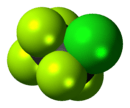Chloropentafluoroethane
| |||
| Names | |||
|---|---|---|---|
| IUPAC name
1-chloro-1,1,2,2,2-pentafluoroethane | |||
| Other names
Freon 115, CFC-115, R-115, Fluorocarbon-115, Genetron 115, Halocarbon 115, Monochloropentafluoroethane | |||
| Identifiers | |||
| 76-15-3 | |||
| 3D model (Jmol) | Interactive image | ||
| ChEMBL | ChEMBL502216 | ||
| ChemSpider | 6190 | ||
| ECHA InfoCard | 100.000.854 | ||
| E number | E945 (glazing agents, ...) | ||
| UNII | SJG47X19V4 | ||
| |||
| |||
| Properties | |||
| C2ClF5 | |||
| Molar mass | 154.466 g/mol | ||
| Appearance | Colorless gas | ||
| Odor | Ethereal | ||
| Melting point | −99 °C (−146 °F; 174 K) | ||
| Boiling point | −39.1 °C (−38.4 °F; 234.1 K) | ||
| 59 mg/L | |||
| Vapor pressure | 7.9 atm (21°C)[1] | ||
| Hazards | |||
| Main hazards | In high concentrations may cause asphyxiation.[2] | ||
| Flash point | 70.4 °C (158.7 °F; 343.5 K) | ||
| US health exposure limits (NIOSH): | |||
| PEL (Permissible) |
none[1] | ||
| REL (Recommended) |
TWA 1000 ppm (6320 mg/m3)[1] | ||
| IDLH (Immediate danger) |
N.D.[1] | ||
| Except where otherwise noted, data are given for materials in their standard state (at 25 °C [77 °F], 100 kPa). | |||
| | |||
| Infobox references | |||
Chloropentafluoroethane is a chlorofluorocarbon once used as a refrigerant. Its production and consumption has been banned since 1 January 1996 under the Montreal Protocol because of its ozone-depleting potential.[3]
References
- 1 2 3 4 "NIOSH Pocket Guide to Chemical Hazards #0131". National Institute for Occupational Safety and Health (NIOSH).
- ↑ http://encyclopedia.airliquide.com/sds/en/030_AL_EN.pdf
- ↑ Ozone Depleting Substances List (Montreal Protocol)
This article is issued from Wikipedia - version of the 11/30/2015. The text is available under the Creative Commons Attribution/Share Alike but additional terms may apply for the media files.

